Abstract
This study examines the effectiveness of pervious concrete pavements as a sustainable and cost-effective stormwater management technique, particularly by incorporating locally sourced recycled materials into their design. It evaluates the stormwater treatment potential of three pervious concrete pavement types incorporating recycled plastic, glass, and crushed concrete aggregates, with six design variations produced using 25% and 50% replacements of coarse aggregates from these materials. The key properties of pervious concrete, namely compressive strength, porosity, unit weight, and infiltration, and key water quality indicators, namely pH, electrical conductivity (EC), total suspended solids (TSS), colour, turbidity, chemical oxygen demand (COD), nitrate (NO3−), and orthophosphate (PO43−), were analysed. Results indicated an overall improvement in the quality of the stormwater runoff passed through all pervious concrete pavements irrespective of composition. Notable reductions in turbidity, TSS, colour, COD, PO43−, and NO3− underscored the effectiveness of pervious concrete containing waste materials in the treatment of stormwater runoff. Pervious concrete pavements with 25% recycled concrete exhibited optimal performance in reducing TSS, COD, and PO43− levels, while the 50% recycled concrete variant excelled in diminishing turbidity. However, the study found that the use of recycled materials in pervious concrete pavements affects properties like compressive strength and infiltration rate differently. While incorporating 25% and 50% recycled concrete aggregates did not significantly reduce compressive strength, the effectiveness of stormwater treatment varied based on the mix design and type of recycled material used. Thus, this study highlights the potential of utilizing recycled waste materials in pervious concrete pavements for sustainable stormwater management.
1. Introduction
Urban stormwater runoff has been identified as a major source of pollution to the receiving water environment and is becoming worse due to rapid urbanization around the world [1,2]. With the rapid urbanization around the globe, a significant increase of urban impervious surfaces such as roofs, roads and parking lots causes an increase in the amount of stormwater runoff due to the very low or no infiltration of water through these surfaces. On the other hand, due to various anthropogenic industrial, residential, institutional, and commercial activities, the amount of pollutants built up on these impermeable surfaces has also increased. As a result, a significant amount of pollutants accumulate and are washed off during rain events. These pollutants mainly include sediments, pathogenic organisms, nutrients, heavy metals, and hydrocarbons, as well as some emerging pollutants like microplastics, all of which pose significant threats to surface water quality and the aquatic ecosystems [3,4,5]. With the growing awareness of stormwater pollution as a major source of pollution, regulatory authorities strive to design and implement various stormwater management strategies to mitigate the negative impacts of stormwater pollution. This mainly includes the design and implementation of low-impact urban design measures, and structural and non-structural best management practices (BMPs). In this context, in recent years, there has been growing interest in the field of pervious concrete pavement systems, especially in the scope of stormwater management [6,7].
Although urban stormwater runoff increases due to the expansion of various types of urban impervious surfaces, it can be managed significantly by incorporating permeable urban surfaces [8,9]. They can potentially reduce the runoff volume and improve the water quality by providing a pervious concrete medium that enables stormwater to infiltrate through a pavement surface that entrap pollutants while acting as a filter layer [10,11]. Furthermore, since there is no additional space requirement for pervious concrete pavements, it is an ideal option for stormwater management for highly urbanized areas which have limited or no space to implement different types of other structural BMPs such as bioswales, rain gardens, constructed wetlands, etc. Therefore, applying pervious concrete pavements has been a trend over the past decades as a viable technique to mitigate both the quantitative and qualitative impacts of urban stormwater runoff [12,13,14]. When evaluating the water quality impacts of pervious concrete pavements, these pavements are often regarded as having 100% efficacy in pollutant removal [15,16]. Traditional, impervious pavements can be upgraded to pervious concrete ones without additional stormwater management features like drainage systems. Compared to impervious systems, maintaining pervious concrete pavement structures is critical to their effectiveness, and the initial cost of pervious concrete pavements is about two to three times higher than that of conventional impervious pavements [17,18]. However, studies have shown that while pervious concrete pavement systems may cost more initially than conventional pavements, they can result in long-term cost benefits by reduced maintenance and stormwater management costs [7,17,18]. The National Pollutant Discharge Elimination System (NPDES) in the United States, which oversees the permitting of stormwater discharges, recognizes the effectiveness of pervious concrete pavements as an optimal BMP for controlling stormwater.
On the other hand, the problem of solid waste is another key environmental issue associated with the rapid growth of population and urbanization around the world [19]. Almost all anthropogenic activities, which include residential, commercial, and industrial activities, generate substantial amounts of solid waste. Among all of them, industrial activities generate more harmful pollutants to the environment relative to the others [20]. The adoption of ineffective waste management strategies in the industrial sector has resulted in adverse environmental consequences and illegal dumping. In recent years, there has been an increasing movement to convert construction waste and debris into valuable and beneficial resources to tackle this problem. When considering industrial waste generation, the construction industry produces a higher amount of solid waste per day compared to other industrial, commercial, and residential sectors [19,21]. The overall construction and demolition waste (C&DW) generation in 40 countries worldwide reached more than 3.0 billion tonnes annually through 2012, and this trend is increasing constantly [22]. Beyond construction waste, the overflowing landfills also grapple with plastics and glass waste generated from various industries, which is 55% and 75% of global generation without recycling [21]. Furthermore, construction demolition and excavation waste (CD&E) generates millions of tons per year, and most of these construction wastes are directly disposed to landfills. Globally, recycling rates of C&DW range between 40–50%, while most developing countries recycle less than 30% of their generated waste, leading to a significant increase in environmental degradation, and it is a very common worldwide problem nowadays [7,21,23]. On the other hand, promoting the use of these recycled waste materials will also lead to addressing the problem of the ongoing depletion of natural resources up to a considerable extent [24].
Furthermore, including recycled waste materials in concrete design has become an emerging trend. Although many studies have explored the use of recycled concrete aggregates in both conventional and pervious concrete [25,26,27], there is a significant gap in understanding their performance characteristics with respect to water quality, which has often been overlooked. While recycled glass and plastics have been investigated in traditional concrete to assess strength and other properties [28], the application of these materials in pervious concrete pavement design remains underexplored. A comprehensive understanding of the performance characteristics of pervious concrete pavements utilizing recycled materials is still lacking, indicating a clear need for further research in this area.
This study specifically targets the recognized gap in knowledge by investigating the performance characteristics of pervious concrete pavements that utilize locally sourced recycled materials, including recycled concrete aggregates, plastics, and glass. By evaluating both the mechanical, physical, and hydraulic properties of these pavements, this research provides a detailed analysis of how different types of recycled materials impact pavement performance. Additionally, the study quantifies the amount of stormwater runoff infiltrated through various recycled-material pavement surfaces and assesses the quality of the filtered stormwater. The findings will provide engineers and practitioners with the knowledge to design and implement pervious concrete pavements as a sustainable stormwater management approach and safeguard the receiving water bodies.
2. Materials and Methods
2.1. Materials
In this study, three recycled materials, namely recycled concrete aggregates (RCA), recycled plastic (RP), and recycled glass (RG), were selected as substitutes for coarse aggregates as shown in Figure 1. The range of 6.3 mm to 10 mm is often chosen to achieve an optimal pore structure that balances strength with porosity. This range allows for sufficient interconnectivity of voids, promoting adequate drainage while maintaining structural integrity [11,25,29]. Therefore, all the aggregates employed in this study were screened to ensure conformity within the size range of 6.3 mm to 10 mm. These recycled materials were chosen considering performance, compatibility, and environmental impacts when disposed to landfills without recycling. In addition, their availability was also considered.

Figure 1.
Unscreened samples of recycled materials used.
Ordinary Portland cement obtained from Tokyo Cement (Lanka) PLC, Colombo, Sri Lanka, specifically in the 42.5 N strength class, was selected as the binding material, and the superplasticizer admixture was incorporated to enhance the workability and flowability of the pervious concrete mix. Master Glenium Sky 8320 obtained from Finex Engineering (PVT) Limited, Colombo, Sri Lanka was selected as the admixture because of its effectiveness in reducing water content while maintaining the necessary fluidity, contributing to the production of well-compacted pervious concrete.
2.2. Methodology
2.2.1. Test Specimen Casting
In this study, a total of seven types of pervious concrete specimens were cast to analyse the quality of stormwater runoff passing through the specimens, including six pervious concrete specimens containing recycled materials and one normal pervious concrete specimen cast with normal aggregates as the control specimen. The mix design was selected from a previous study which was adapted from a comparison of M15, M20, and M25 grades of pervious concrete with conventional concrete to design the concrete specimens [30]. For this study, the M25 grade was chosen, as it is the most used design for such applications. Details of the mix design are provided in Table 1.

Table 1.
Details of mix design.
In accordance with the above-stated mix design, two different mix designs were implemented for each recycled material by replacing the aggregate content with 50% and 25% recycled materials. The control sample with a standard amount of aggregates was used to compare the overall results and the suitability of each recycled material. test samples were cast to and analyse the infiltration rate and water quality. In addition, size cube specimens were cast to test the compressive strength in 14 and 28 days. All the materials were taken according to the mix design, and mixed using the mixer; the test cube mould was filled in two equal lifts, and each lift was compacted by 20 blows with a standard proctor hammer. After casting the cubes, the curing process was continued up to the date of testing [31]. The cast test samples are shown in Figure 2.
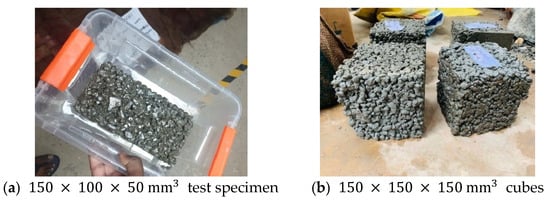
Figure 2.
(a) Pervious concrete pavement specimen; (b) compressive strength test specimen.
2.2.2. Stormwater Samples Collection
Stormwater samples were systematically collected on three separate days over two months from a road surface located within the urban area near the university. The location was selected due to its accessibility and to obtain a stormwater runoff sample that was as representative as possible. The sheet flow method [32] was used to collect runoff from an impermeable surface within 10 to 20 min of a measurable rain event, which is greater or equal to 0.2 mm as per the standards provided by the World Meteorological Organization [33].
2.2.3. Experimental Setup Preparation
Each specimen was placed in a glass box measuring 150 × 100 × 200 mm3, which allowed stormwater to pass through it. The filtrated water was then collected for subsequent analysis of water quality parameters. (Figure 3). The cast pervious concrete pavement specimen was placed in the glass box after 7 days of curing. The specimen was sealed to the glass box using silicone waterproof sealant and placed on the top of the transparent tub. Then, the filtered water was collected into the tub for testing, as shown in Figure 3. Special care was taken to prevent contamination of the plastic tub by thoroughly cleaning it with deionized water before each use and conducting interim analyses of water quality parameters to ensure that it did not contaminate the filtered samples.
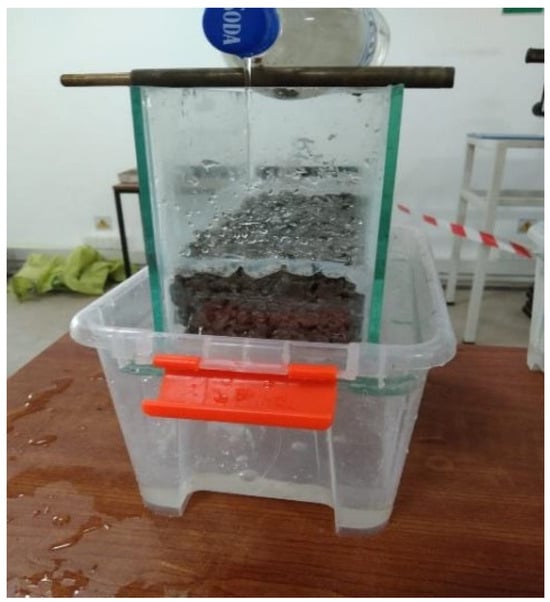
Figure 3.
Water quality analysis experimental setup.
2.2.4. Analysis of Hydraulic Properties and Water Quality Parameters
The infiltration rate for each mix design was evaluated using the volume of water that infiltrates through each pervious concrete pavement at a specific time interval. The infiltration rate () was calculated using the volume of infiltrated water , cross-sectional area of the specimen , and time (t) required for the measured volume of water to infiltrate through the concrete using Equation (1).
Then, the quality of both the stormwater runoff and the filtrate obtained after passing through the pervious concrete pavement specimens was examined using several key water quality parameters, namely pH, electrical conductivity (EC), total suspended solids (TSS), chemical oxygen demand (COD), colour, turbidity, orthophosphate (PO43−), and nitrate (NO3−), according to the methods specified in APHA 2005 [34], as shown in Table 2.

Table 2.
Test methods used for each parameter.
2.2.5. Analysis of Mechanical and Physical Properties
To assess the compressive strength of the pervious concrete mixture, a total of six specimens were prepared for each mix design. These specimens were cast and tested after a duration of 14 and 28 days. As discussed in Section 2.2.1 the evaluation of compressive strength was conducted using cube-shaped specimens with a size of 150 mm × 150 mm × 150 mm. The testing procedure was performed as per the guidelines outlined in IS 516-1959 [36]. In addition, the unit weight of the pervious concrete was measured using the test method ASTM C1688 [37]. Furthermore, the porosity of each sample was measured using the water displacement method.
3. Results and Discussion
3.1. Filtered Stormwater Water Quality Analysis
As described in Section 2.2.4, each of the original stormwater samples and the filtered water underwent comprehensive testing for eight key water quality parameters. The results obtained for each water quality parameter are discussed below. To compare the overall results, two sets of graphs were plotted indicating the variation of the obtained value of each parameter in each set of samples, and the variation of the average value of each parameter with the removal efficiency compared to the raw water sample.
The pollutant removal efficiency was calculated based on the change of the average value of each water quality parameter in the filtrates compared to the raw water sample as a percentage as illustrated by the following equation.
where:
- Average Value = average of the filtered stormwater samples
- Raw Water Value = initial value of the parameter in the raw water sample
3.1.1. pH
The pH of stormwater runoff is an important criterion in determining the water quality impacts of different urban land uses. The pH of water, which measures its acidity or alkalinity, is crucial in determining the overall health of aquatic habitats. Stormwater runoff, which is frequently characterized by fast flow and exposure to numerous contaminants, can have a broad range of pH values. Understanding and monitoring the pH of stormwater runoff is critical for assessing its possible impacts on receiving water bodies such as rivers and streams. An acceptable pH range for receiving water bodies is often between neutral and slightly alkaline. Acidic or highly alkaline conditions can be hazardous to aquatic life and ecosystem health because they alter the chemical speciation and toxicity of metals in runoff [2].
The results obtained for pH levels in the raw water and the filtrate for each day are shown in Figure 4a. Figure 4b shows the average pH variation for each type of pervious concrete pavement and the change of pH as a percentage compared to the raw water.
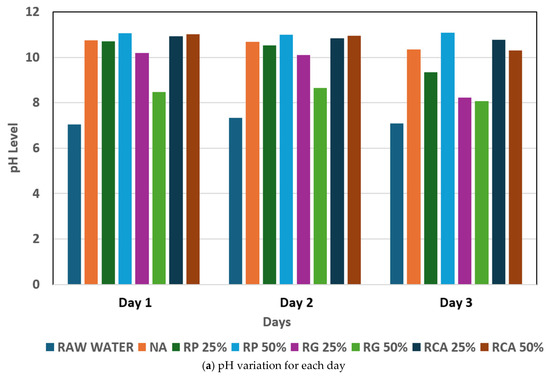
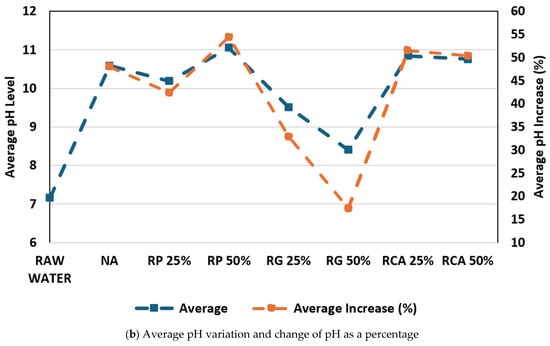
Figure 4.
Variation of pH.
As can be seen in Figure 4a, the pH of each raw stormwater sample was approximately 7.16, which is considered neutral. However, after passing through the various pervious concrete pavement specimens, the pH of all filtrates increased to values above 8, indicating alkaline conditions. This increase in pH suggests that the pervious concrete mixes impart alkalinity to the filtrated water due to the presence of cementitious materials. Similar trends have been reported in previous studies that examined the influence of pervious concrete on water quality [38]. This is expected as the stormwater seeps through the inherently alkaline concrete matrix. Nonetheless, it can be argued that this effect may gradually diminish over time as the concrete undergoes carbonation. Figure 4b illustrates the average pH values recorded for each type of pervious concrete pavement specimen, along with the average percentage increase in pH relative to the raw water. Interestingly, as shown in Figure 4b, compared to normal pervious concrete made with 100% normal aggregates, the pervious concrete pavements containing recycled glass exhibited a smaller increase in pH, which is less than approximately 35% in the filtrates. Furthermore, the minimum increase in pH also can be seen from the pervious concrete pavements made with recycled glass. This indicates that glass as a material has no significant impact on pH in the seeped water compared to that in the pavements containing plastic and recycled concrete aggregates.
3.1.2. Electrical Conductivity (EC)
The concentration of dissolved ions and salts in stormwater is determined by EC and it provides critical information about its overall quality and potential environmental effect. The EC of stormwater runoff can vary greatly depending on the surrounding land use, the quantity of impermeable surfaces, and the presence of contaminants. Stormwater runoff with higher EC values may suggest a potential risk of water quality degradation. Monitoring and regulating EC in stormwater runoff helps to avoid negative effects of stormwater runoff on aquatic ecosystems, since excessive conductivity can disturb ion balance and significantly influence aquatic life. The results obtained from EC measurements in the raw water and the filtrate for each day are shown in Figure 5a. Figure 5b shows the change of EC as a percentage compared to the raw water and average EC for each type of pervious concrete pavement.
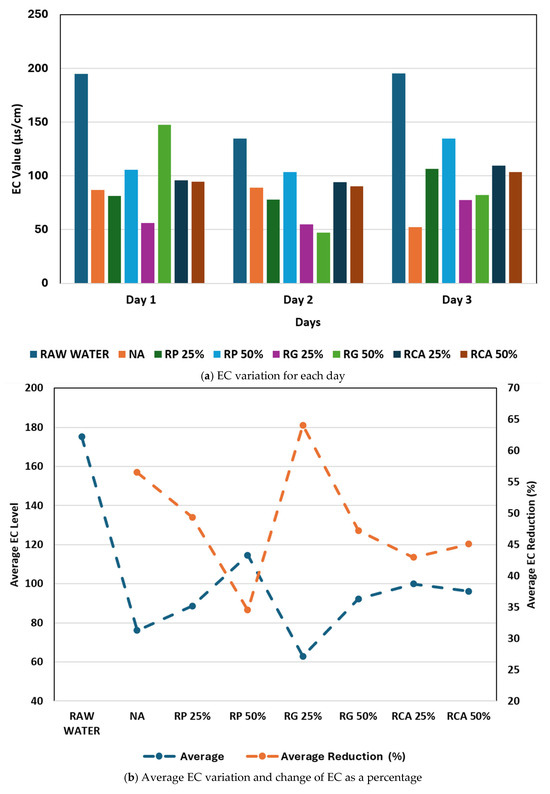
Figure 5.
Variation of electrical conductivity.
As can be seen in Figure 5a, the average EC of raw water was 175 µs/cm. The filtrate obtained from all types of pervious concrete pavements shows a significant reduction of EC when compared to the raw water. As shown in Figure 5b, the highest reduction (around 64%) is recorded by the pervious concrete pavement containing 25% recycled glass. The pervious concrete pavement containing 100% normal aggregates shows the second-highest reduction in EC. This can be attributed to variations in pore characteristics caused by factors such as the formation of cement hydration products, which alter the microstructure and increase small volume pores in the concrete specimens [39].
3.1.3. Turbidity
Turbidity is a measure of the degree of cloudiness in the water or other words an indicator of solids present. Stormwater runoff transports numerous contaminants as they pass impermeable surfaces and diverse land uses, considerably impacting the turbidity levels of nearby water bodies. Turbidity measurement gives vital information about the visual quality of water by reflecting the quantity of suspended particles that might limit light penetration and, as a result, harm aquatic ecosystems. Elevated turbidity levels may limit sunlight penetration, decreasing photosynthesis and disturbing aquatic organisms’ habitat. Furthermore, suspended particles in stormwater runoff act as carriers for loads of other pollutants, affecting water quality in ways other than visual clarity [1,2,15]. The observations for turbidity in the raw water and the filtrate for each day are shown in Figure 6a below. Figure 6b shows the average turbidity of the filtrates obtained from each type of pervious concrete pavement specimen and the removal efficiency compared to the raw water.
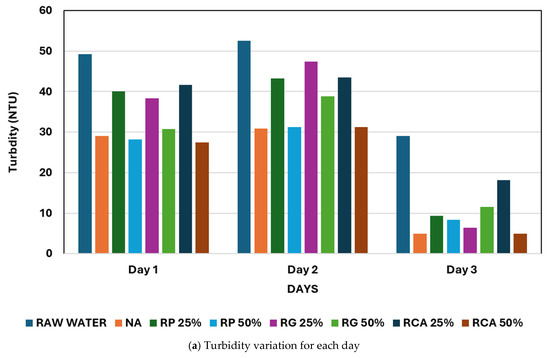
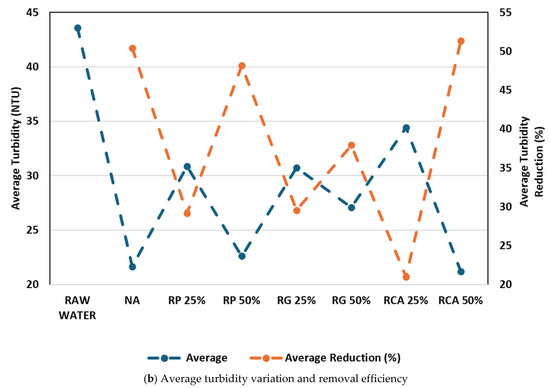
Figure 6.
Variation of turbidity.
In this study, the average turbidity of raw stormwater runoff samples was found as 43.6 NTU. As shown in Figure 6a, the filtrates obtained from all the different types of pervious concrete pavements show a lower turbidity value than the raw water. The highest reduction in turbidity can be seen from pervious concrete containing 50% recycled concrete aggregates (51.36%). This can be attributed to the increase in permeability and porosity with the higher proportion of recycled concrete aggregates in the concrete mix. This is further strengthened by the observation that the removal efficiency is increasing with the increase of the amount of waste material in all the pervious concrete pavement types containing recycled waste materials, as illustrated in Figure 6b.
3.1.4. Total Suspended Solids (TSS)
Total suspended solids (TSS) are a crucial parameter for evaluating water quality. As urban areas grow, the rise in impermeable surfaces enhances the likelihood of runoff transporting various contaminants, with TSS serving as a significant indicator of the particulate matter and sediment found in water. TSS refers to particles that exceed two microns in size encompassing various materials such as soil, silt, organic matter, debris, and pollutants. Higher levels of TSS in stormwater runoff are often indicative of increased pollution and sedimentation. The obtained results for TSS in the raw stormwater runoff and the filtrate for each day are shown in Figure 7a. Figure 7b shows the average TSS of the filtrates obtained from each type of pervious concrete pavement specimen and its removal efficiency compared to the raw water.
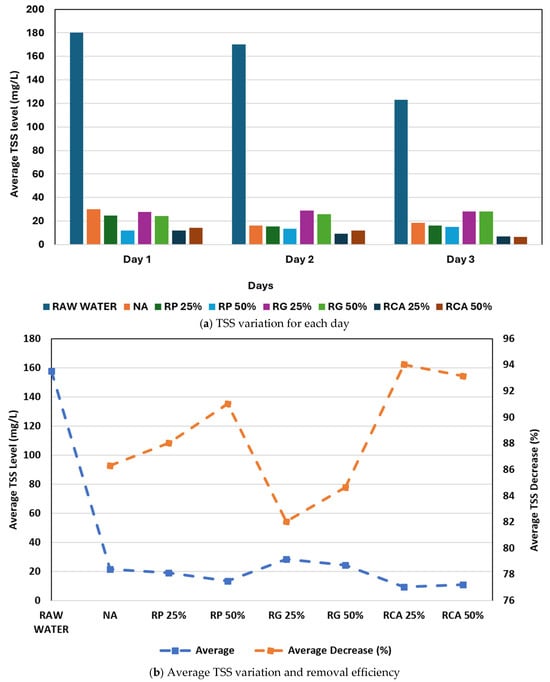
Figure 7.
Variation of total suspended solids concentrations.
According to Figure 7a, all the filtrates recorded a considerably lower TSS when compared to the raw water samples which indicates that all the pervious concrete pavements can substantially trap the organic matter, debris, and pollutants in stormwater runoff and therefore lead to a significant reduction in total suspended solids in the filtrates. When stormwater, carrying its suspended sediment, enters the system, it flows slowly, facilitating sediment entrapment [40]. As can be seen in Figure 7b, all the pervious concrete pavements remove more than 80% of TSS, which indicates the effectiveness of the implementation of pervious concrete pavements not only for the management of the quantity of stormwater runoff but also for improving the quality of the stormwater.
Interestingly, as shown in Figure 7b, 25% recycled concrete aggregate pervious concrete pavement shows the highest reduction of TSS (around 94%), which is closely followed by the 50% recycled concrete aggregate pervious concrete specimen. On one hand, this can be attributed to the increase in porosity of pervious concrete due to the introduction of recycled concrete aggregates as discussed in Section 3.1.3 [41,42]. On the other hand, it can be argued that the reduction of TSS (particles greater than two microns) can be particularly due to the increase of small pore sizes and the pore area in the concrete with recycled concrete aggregates. This conforms with the findings of Miguntanna et al. [42], who compared the porosity and pore size distributions of a control concrete made with natural coarse aggregates and different levels of recycled concrete aggregates and noted that 0.0157 µm pore diameter in pervious concrete with 50% recycled concrete aggregates. Additionally, according to the findings of Miguntanna et al. [42], the total pore area decreases as the proportion of recycled concrete aggregates increases. This further supports the observation that the reduction of total suspended solids (TSS) is relatively low in mixtures with 50% recycled concrete aggregates compared to those with 25% recycled concrete aggregates, as illustrated in Figure 7b.
3.1.5. Colour
The colour of stormwater runoff is a critical parameter in assessing urban stormwater runoff’s quality and potential environmental impact. Stormwater runoff, as it courses through impervious surfaces, carries a diverse array of pollutants, giving rise to variations in colour. The colour of stormwater is an indicator of the presence and concentration of particulate matter, dissolved substances, and contaminants that can influence water quality. The result obtained for colour variation in the raw water and the filtrate for each day is shown in Figure 8a. Figure 8b shows the average colour of the filtrates obtained from each type of pervious concrete pavement specimen and its removal efficiency compared to the raw water. As can be seen in Figure 8a,b, almost all the filtrates show more than a 70% reduction in colour compared to the colour of the raw water sample, which indicates that the pollutants such as suspended solids, organic matter, and other contaminants are trapped when passing through every type of pervious concrete. As shown in Figure 8b, the highest removal efficiency of colour (around 82%) can be seen in the pervious concrete pavement containing 25% recycled glass.
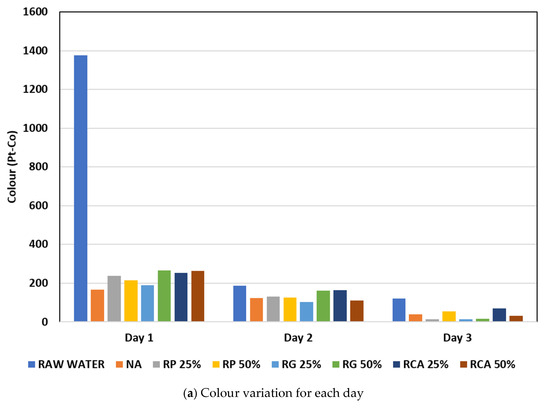
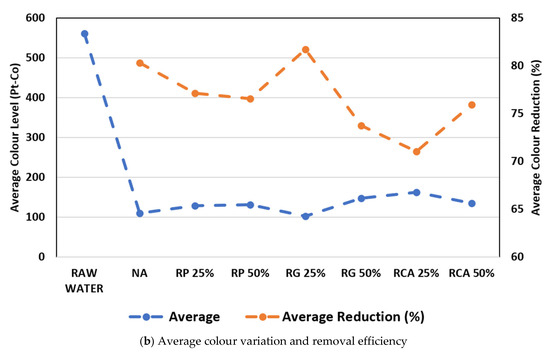
Figure 8.
Variation of colour.
3.1.6. Chemical Oxygen Demand (COD)
The concentration of COD in stormwater runoff serves as a key indicator of the extent of organic and oxidizable inorganic pollutants present. COD is a measure of the amount of oxygen required for the chemical oxidation of organic and inorganic substances present in water. These pollutants may originate from various anthropogenic activities, such as industrial discharges, vehicular emissions, and runoff from paved surfaces. Elevated COD levels can lead to oxygen depletion in receiving water bodies, negatively impacting aquatic ecosystems. The result obtained for COD variation in the raw water and the filtrate for each day is shown in Figure 9a. Figure 9b shows the average COD variation for each type of pervious concrete pavement specimen and removal efficiency compared to the raw water.
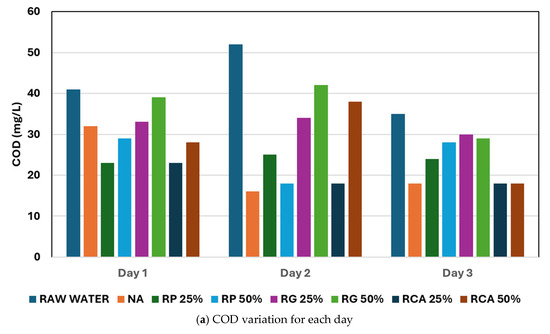
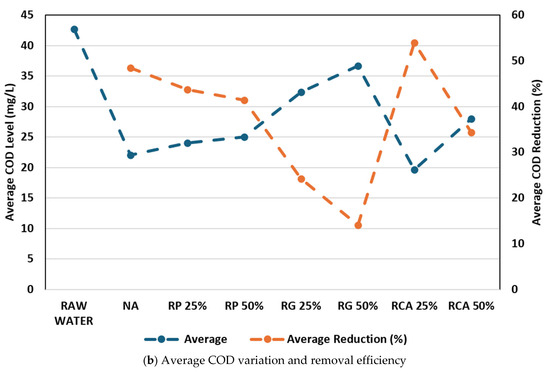
Figure 9.
Variation of COD.
As shown in Figure 9a, the COD has been decreased in all the filtrates indicating the reduction in the concentration of organic and oxidizable inorganic substances when passing through every pervious concrete pavement. According to Figure 9b, the highest removal efficiency of COD can be seen in the pervious concrete pavement which contains 25% recycled concrete aggregates. The results obtained in this study agree with the outcomes of several other research studies. The study conducted by Faisal et al. [43] investigated the possibility of using pervious concrete pavements designed with varying aggregate sizes, water-to-cement ratio, and cement content in wastewater clarification and observed a maximum COD removal efficiency of 54%. Furthermore, Pilon et al. [38], in their analysis of the water quality of samples taken from untreated asphalt runoff and runoff that had passed through the pervious concrete detention system, observed a statistically significant reduction in COD levels in the runoff that flowed through the pervious concrete system. Another study was conducted by Horst et al. [44] to assess the effect of precast pervious concrete on the enhancement of river water quality over two years. The findings revealed a 30% to 60% reduction in BOD and COD levels in the river water following the introduction of pervious concrete products into the river.
3.1.7. Orthophosphate (PO43−)
The phosphorus concentration in the stormwater runoff serves as a key indicator of potential nutrient loading in receiving waters. Phosphorus, in its various forms, can stimulate the growth of algae and aquatic plants, leading to ecological imbalances and water quality degradation [45]. As urbanization expands and impervious surfaces proliferate, stormwater runoff becomes a carrier of phosphorus generated from various anthropogenic sources, including fertilizers, detergents, and organic matter. Therefore, the assessment of phosphorus levels in stormwater is integral to understanding and hence to mitigate the impacts of urban stormwater runoff on aquatic environments. The results obtained for PO43− variation in the raw water and the filtrate for each day are shown in Figure 10a. Figure 10b shows the average PO43− variation of the filtrate obtained for each type of pervious concrete pavement and removal efficiency compared to the raw water. According to Figure 10a, all the filtrates show a reduction in PO43− concentration compared to raw water samples, further strengthening the capability of pervious concrete pavements to improve the stormwater quality.
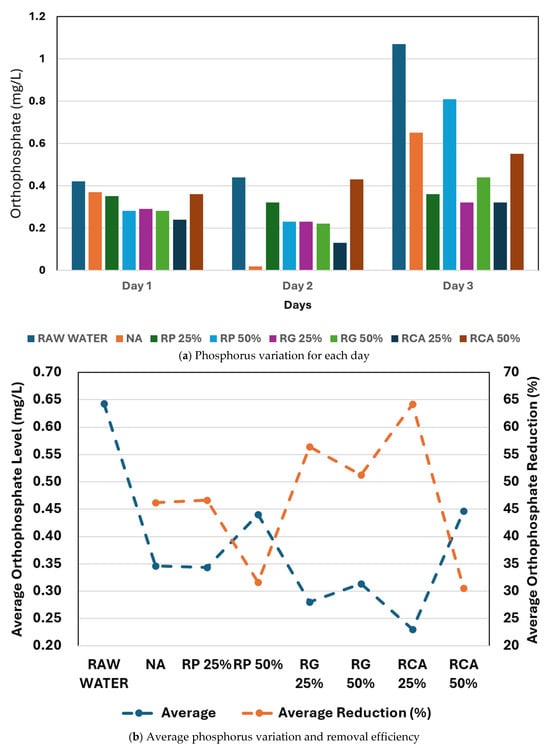
Figure 10.
Variation of orthophosphate (PO43−) concentrations.
However, a study focusing on the assessment of the multilayer performance of a pervious concrete infiltration basin indicates that pervious concrete has 94.3% phosphorous removal efficiency [44]. According to Figure 10b, the highest removal efficiency for PO43− is shown by the pervious concrete pavement specimen containing 25% recycled concrete aggregates (64.25%). Interestingly, as shown in Figure 7b, the highest reduction of TSS is also given by the pervious concrete pavement specimen containing 25% recycled aggregates. This is well in conformity with the findings of Miguntanna et al. [42] who found that phosphorous in the wash-off is predominantly in the particulate form.
3.1.8. Nitrate
Stormwater runoff serves as a vital source of nutrient loading into receiving waters [41,42]. This high nitrogen input often triggers excessive algal blooms, which in turn reduce dissolved oxygen levels, leading to widespread fish kills and disrupting aquatic ecosystems. Stormwater runoff carries different forms of nitrogen such as NO3-N, TKN, etc. which are most commonly derived from lawn fertilizer, detergents, animal waste, atmospheric deposition, organic matter, vehicle exhausts, and improperly installed or failing on-site wastewater treatment systems [41,46]. Figure 11a shows the variation of nitrate in the filtrates compared to raw water whereas, Figure 11b shows removal efficiency compared to the raw water and average nitrate variation in the filtrates obtained for each type of pervious concrete pavements. As shown in Figure 11a, significant nitrate reduction (more than 70%) can be seen in every pervious concrete pavement type compared to the raw water. The reason for this significant reduction is the permeable structure of pervious concrete acts as a filter, allowing water to pass through while capturing and retaining impurities, including nitrates [47]. Additionally, the concrete’s surface may provide sites for adsorption, where nitrate ions adhere to the concrete matrix, effectively removing them from the water. When comparing each pavement specimen, the pavement specimen containing 50% recycled plastics shows the highest average reduction.
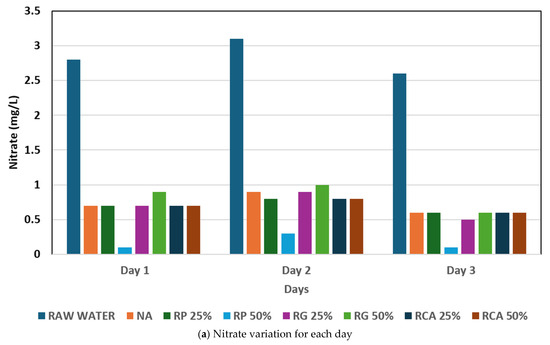
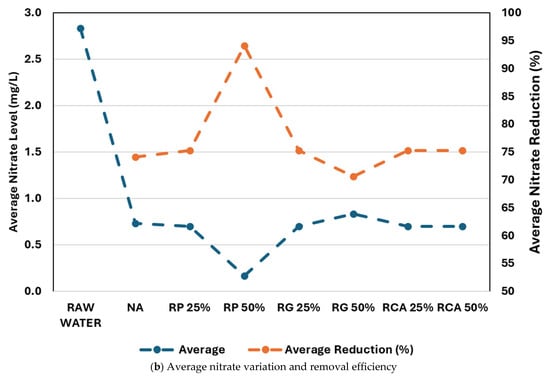
Figure 11.
Variation of nitrate concentrations.
3.2. Analysis of Mechanical, Physical, and Hydraulic Properties
3.2.1. Compressive Strength
Figure 12 shows the compressive strength obtained by each type of pervious concrete mix design in 14 and 28 days. Pervious concrete mix designs that include 25% and 50% recycled concrete aggregates demonstrate slightly higher compressive strength than those that use normal aggregates. However, on the other hand, previous studies, show that pervious concrete with normal aggregate has higher compressive strength than its equivalent including recycled material [25,48]. This can be attributed to several reasons. Firstly, the improvement of compressive strength due to the addition of admixture during the preparation of pervious concrete specimens is described in Section 2.1 [48]. The newly formed cementitious compounds contribute to the development of additional bonding within the concrete matrix leading to enhanced strength. Secondly, recycled concrete aggregates often have higher surface roughness compared to relatively smooth surfaces of natural aggregates. This increased roughness can increase the contact area between neighbouring aggregate particles and the surrounding cement paste resulting in improved compressive strength.
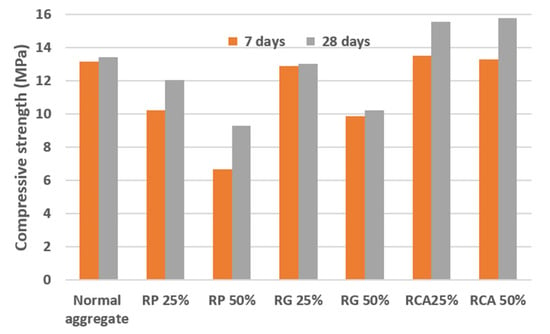
Figure 12.
Compressive strength variation.
This argument is further supported by the observation that the pervious concrete specimen with 50% recycled concrete aggregate exhibits the highest compressive strength, followed closely by the specimen containing 25% recycled concrete aggregate. Furthermore, based on the quality standards for pervious concrete in various applications, the average compressive strength of the pervious pavement with recycled concrete aggregates meets the minimum requirements for use in parks and sidewalks [49,50].
3.2.2. Infiltration Rate
Figure 13 shows the highest infiltration rate by the concrete specimen containing 25% recycled concrete aggregates, followed by 50% recycled concrete aggregates. Adding recycled concrete aggregates leads to increased porosity in the concrete mix due to several factors. Firstly, recycled concrete aggregates generally have a more irregular shape and rougher surface texture than natural aggregates. This roughness and irregularity can prevent the aggregates from packing as tightly together, resulting in more void spaces between the aggregates which eventually increases the porosity [25]. Secondly, pervious concrete with recycled aggregate contains not only virgin aggregate but also hydrated cement paste, which reduces the specific gravity and increases porosity. Furthermore, recycled concrete aggregates tend to have higher water absorption due to adhered mortar from the original concrete. This adhered mortar is more pervious concrete than natural aggregates, contributing to an overall increase in the porosity of the recycled concrete aggregates. This increased porosity in the aggregates themselves can lead to a higher void ratio in the concrete mix. Moreover, recycled concrete aggregates often contain microcracks from the crushing and recycling process. These microcracks further contribute to an increase in the overall void spaces within the concrete which also leads to an increase in porosity [25,51].
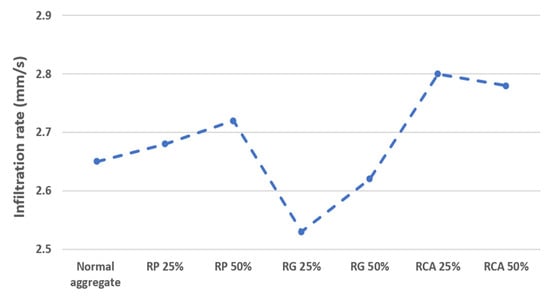
Figure 13.
Infiltration rate vs. type of pervious concrete.
3.2.3. Correlation Between the Porosity, Infiltration Rate, and TSS Removal Efficiency
Figure 14 shows the variation of infiltration rate and TSS removal efficiency with porosity for all the different types of pervious concrete pavement specimens. As can be seen in Figure 14a there is a strong positive linear correlation (R2 = 0.93) between the porosity of the concrete and the infiltration rate. On the other hand, as shown in Figure 14b a strong correlation also exists between (R2 = 0.98) TSS removal efficiency and the porosity for all pervious concrete specimens. This indicates that both the infiltration rate and the TSS removal potential of pervious concrete are increasing when the porosity of the concrete increases. These findings further reinforce the effectiveness of pervious concrete pavements in the context of stormwater management, particularly from both qualitative and quantitative perspectives. However, in this context, the selection of mixed design and the type of waste material is dependent on the required compressive strength, which depends on the expected usage requirements such as sidewalks, parking slots, etc.
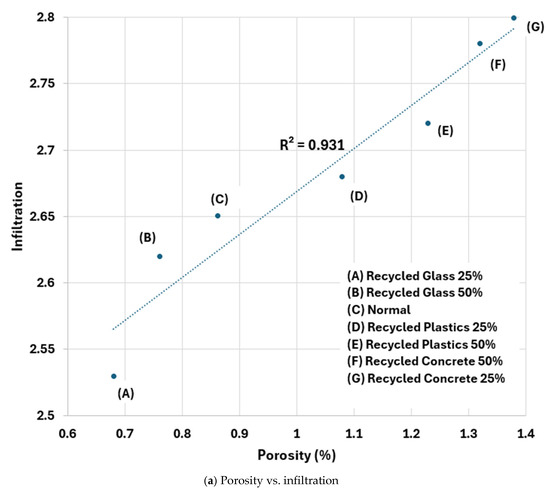
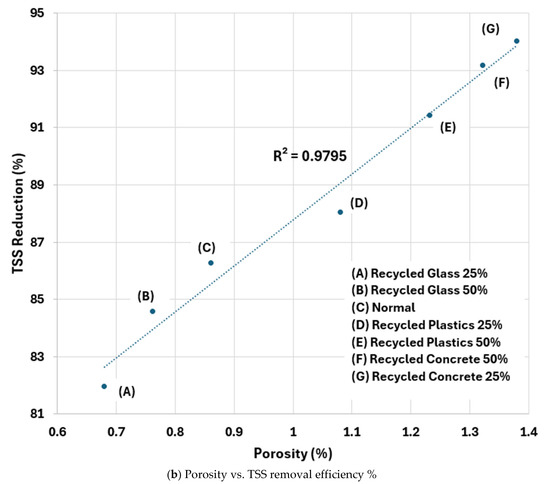
Figure 14.
Variation of infiltration rate and TSS removal efficiency with porosity.
3.3. Summary of the Mechanical, Physical and Hydraulic Properties
As discussed in Section 2, in this study, the mechanical, physical, and hydraulic properties of different types of pervious concrete mix designs were also analysed to better understand the stormwater treatment potential of pervious concrete pavements. This includes compressive strength, unit weight and porosity, and infiltration rate. Table 3 summarizes the test results obtained for each type of pervious concrete mix design. The test results indicate that for both recycled plastics and recycled glass, increasing the proportion of recycled materials led to greater porosity, which in turn increased the infiltration rate. In contrast, the recycled concrete aggregates exhibited a different trend; as the percentage of recycled material increased, the porosity decreased. This can be attributed to the dissolution of cementitious particles and the introduction of fine particles from recycled concrete aggregates which could clog the void spaces in pervious concrete. In addition to porosity and infiltration rate, compressive strength and unit weight also varied across the different mixes. Recycled plastic mixes showed a reduction in compressive strength and unit weight as the percentage of plastic increased, potentially limiting their application to lower-load areas. Conversely, recycled concrete aggregates (RCA) increased compressive strength and unit weight, indicating suitability for higher-load applications due to improved structural performance.

Table 3.
Summary of test results.
3.4. Significance of This Research Work to the Growing Environmental Concerns
This research on pervious concrete pavements containing recycled materials addresses several pressing environmental concerns. By demonstrating the effectiveness of these pavements in improving stormwater runoff quality, the study offers a sustainable solution to urban water pollution and flood management. The successful integration of recycled concrete, plastic, and glass not only reduces waste but also conserves natural resources, aligning with the principles of the circular economy. Furthermore, the improved stormwater filtration capabilities of these pavements can help mitigate the impacts of increased urbanization and climate change-induced extreme weather events. By optimizing the use of locally available recycled waste materials, this research provides a sustainable approach to urban infrastructure development, potentially reducing the carbon footprint associated with traditional pavement construction while simultaneously addressing water quality issues.
4. Conclusions
This study performed a comprehensive water quality analysis to evaluate how effective pervious concrete pavements made with different recycled waste materials are at enhancing the quality of stormwater runoff. Raw stormwater samples were systematically collected over three days spanning over two months and analysed for eight key water quality parameters. The study showcased significant enhancements in water quality following the passage of stormwater through pervious concrete pavements, highlighting their potential to combat pollution. However, notable reductions in key water quality parameters such as turbidity, total suspended solids (TSS), colouration, COD, phosphorous, and nitrate underscored the effectiveness of pervious concrete containing waste materials in treating stormwater runoff. Among the variations tested, pervious concrete with 25% recycled concrete aggregates exhibited optimal performance in reducing TSS, COD, and phosphorous levels, while the 50% recycled concrete variant excelled in diminishing turbidity. Moreover, the 25% recycled glass composition demonstrated notable improvements in enhancing colour and lowering EC values, whereas the 50% recycled glass formulation maintained minimum change in the pH range. Remarkably, the 50% recycled glass configuration showcased superior nitrate removal capabilities.
Additionally, the study evaluated the mechanical, physical, and hydraulic attributes of pervious concrete, such as compressive strength, porosity, and infiltration rate. Results revealed varying impacts of recycled materials on these properties. Both 50% and 25% recycled concrete aggregates exhibited almost identical superior performance in compressive strength. Specifically, the substitution of 25% recycled concrete aggregates yielded optimal porosity. Moreover, pervious concrete pavement containing 25% recycled concrete aggregates demonstrated the highest infiltration rate, while the 50% recycled concrete variant showcased the second-best results. These findings emphasize the necessity of carefully selecting the type and proportion of recycled materials when designing pervious concrete pavements. Furthermore, the relationship between porosity and infiltration rate and porosity and pollutant reduction were analysed. The strong correlations observed between porosity and both infiltration rate and TSS reduction emphasize the significance of porosity in determining the performance of pervious concrete in stormwater management.
In summary, the study advocates for the adoption of pervious concrete pavements as a sustainable approach to stormwater management, particularly with the integration of recycled materials. Recycled concrete at 25% demonstrated superior performance compared to other materials. However, a thoughtful selection of recycled materials and their proportions is essential for optimizing pavement performance. Future investigations could delve into refining pervious concrete mix designs and the influence of key design parameters such as the inclination of the surface to enhance pollutant removal efficiency and ensure the durability of stormwater management infrastructure.
Author Contributions
T.A.G.: Contributed to methodology development, data collection, analysis, and manuscript drafting; K.D.S.: Contributed to data collection, analysis, and manuscript drafting and assisted with methodology development and data interpretation; N.M. (Nandika Miguntanna): Application and recipient of funding, supervised the research process, provided critical revisions, and ensured overall coherence of the manuscript; N.M. (Nadeeka Miguntanna): Supported the funding application, literature review, provided technical expertise during the data collection, and manuscript editing; U.R.: Provided conceptual guidance, reviewed the final draft, and contributed to the discussion and conclusion sections. N.M. (Nitin Muttil): Reviewed the final draft. All authors have read and agreed to the published version of the manuscript.
Funding
This work was supported by the SLIIT annual research grant scheme 2023. (PVC(R&I)/RG/2023/16).
Data Availability Statement
Data used in this paper are available on request for research purposes.
Conflicts of Interest
The authors declare no conflicts of interest.
References
- Malaviya, P.; Singh, A. Constructed wetlands for management of Urban Stormwater Runoff. Crit. Rev. Environ. Sci. Technol. 2012, 42, 2153–2214. [Google Scholar] [CrossRef]
- Pitt, R.; Field, R.; Lalor, M.; Brown, M. Urban Stormwater Toxic Pollutants: Assessment, sources, and treatability. Water Environ. Res. 1995, 67, 260–275. [Google Scholar] [CrossRef]
- Winston, R.J.; Arend, K.; Dorsey, J.D.; Hunt, W.F. Water quality performance of a permeable pavement and stormwater harvesting treatment train stormwater control measure. Blue-Green Syst. 2020, 2, 91–111. [Google Scholar] [CrossRef]
- Beecham, S.; Pezzaniti, D.; Kandasamy, J. Stormwater treatment using permeable pavements. Proc. Inst. Civ. Eng.-Water Manag. 2012, 165, 161–170. [Google Scholar] [CrossRef]
- Nguyen, M.-K.; Lin, C.; Nguyen, H.-L.; Le, V.-R.; Kl, P.; Singh, J.; Chang, S.W.; Um, M.-J.; Nguyen, D.D. Emergence of microplastics in the aquatic ecosystem and their potential effects on health risks: The insights into Vietnam. J. Environ. Manag. 2023, 344, 118499. [Google Scholar] [CrossRef]
- Harada, S. Application of porous concrete infiltration techniques to street stormwater inlets that simultaneously mitigate against non-point heavy metal pollution and stormwater runoff reduction in urban areas: Catchment-scale evaluation of the potential of discrete and small-scale techniques. Water 2023, 15, 1998. [Google Scholar] [CrossRef]
- Chandrappa, A.K.; Biligiri, K.P. Pervious concrete as a sustainable pavement material—Research findings and future prospects: A state-of-the-art review. Constr. Build. Mater. 2016, 111, 262–274. [Google Scholar] [CrossRef]
- Li, H.; Harvey, J.T.; Holland, T.J.; Kayhanian, M. The use of reflective and permeable pavements as a potential practice for Heat Island mitigation and Stormwater Management. Environ. Res. Lett. 2013, 8, 015023. [Google Scholar] [CrossRef]
- Kevern, J.; Haselbach, L.; Schaefer, V. Hot Weather Comparative Heat Balances in Pervious Concrete and Impervious Concrete Pavement Systems. J. Heat Isl. Inst. Int. 2012, 7, 231–237. [Google Scholar]
- Abdel Rahman, R.O.; El-Kamash, A.M.; Hung, Y.-T. Permeable concrete barriers to control water pollution: A Review. Water 2023, 15, 3867. [Google Scholar] [CrossRef]
- Lopez, N.; Collado, E.; Diacos, L.A.; Morente, H.D. Evaluation of pervious concrete utilizing recycled HDPE as partial replacement of coarse aggregate with acrylic as additive. MATEC Web Conf. 2019, 258, 01018. [Google Scholar] [CrossRef]
- Holzer, K.; Poor, C. Reduction of Runoff Pollutants from Major Arterial Roads Using Porous Pavement. Sustainability 2024, 16, 7506. [Google Scholar] [CrossRef]
- Lim, T.C.; Welty, C. Effects of spatial configuration of imperviousness and Green Infrastructure Networks on hydrologic response in a residential sewershed. Water Resour. Res. 2017, 53, 8084–8104. [Google Scholar] [CrossRef]
- Sonebi, M.; Bassuoni, M.; Yahia, A. Pervious concrete: Mix Design. properties and applications. RILEM Tech. Lett. 2016, 1, 109–115. [Google Scholar] [CrossRef]
- Legret, M.; Colandini, V. Effects of a porous pavement with reservoir structure on runoff water: Water quality and fate of heavy metals. Water Sci. Technol. 1999, 39, 111–117. [Google Scholar] [CrossRef]
- Zhang, K.; Yong, F.; McCarthy, D.T.; Deletic, A. Predicting long term removal of heavy metals from porous pavements for stormwater treatment. Water Res. 2018, 142, 236–245. [Google Scholar] [CrossRef]
- Mullaney, J.; Lucke, T. Practical Review of Pervious Pavement Designs. CLEAN–Soil Air Water 2013, 42, 111–124. [Google Scholar] [CrossRef]
- Antunes, L.N.; Ghisi, E.; Thives, L.P. Permeable Pavements Life Cycle Assessment: A literature review. Water 2018, 10, 1575. [Google Scholar] [CrossRef]
- Vij, D. Urbanization and solid waste management in India: Present practices and future challenges. Procedia-Soc. Behav. Sci. 2012, 37, 437–447. [Google Scholar] [CrossRef]
- Kipkurui, A. An Assessment of Industrial Solid Waste Management in Eldoret. Ph.D. Dissertation, University of Nairobi, Nairobi, Kenya, 1997. [Google Scholar]
- Akhtar, A.; Sarmah, A.K. Construction and demolition waste generation and properties of recycled aggregate concrete: A global perspective. J. Clean. Prod. 2018, 186, 262–281. [Google Scholar] [CrossRef]
- Nejad, S.S.; Abedi-Koupai, J.; Mostafazadeh-Fard, S.; Behfarnia, K. Treatment of urban stormwater using adsorbent porous concrete. Proc. Inst. Civ. Eng.-Water Manag. 2018, 171, 328–334. [Google Scholar] [CrossRef]
- Xie, H.-Z.; Li, L.G.; Ng, P.-L.; Liu, F. Effects of solid waste reutilization on the performance of Pervious Concrete: A Review. Sustainability 2023, 15, 6105. [Google Scholar] [CrossRef]
- Ahmad, W.; Ahmad, A.; Ostrowski, K.A.; Aslam, F.; Joyklad, P. A scientometric review of waste material utilization in concrete for sustainable construction. Case Stud. Constr. Mater. 2021, 15, e00683. [Google Scholar] [CrossRef]
- Bhutta, M.A.R.; Hasanah, N.; Farhayu, N.; Hussin, M.W.; Tahir, M.b.M.; Mirza, J. Properties of porous concrete from waste crushed concrete (recycled aggregate). Constr. Build. Mater. 2013, 47, 1243–1248. [Google Scholar] [CrossRef]
- Zaharieva, R.; Buyle-Bodin, F.; Skoczylas, F.; Wirquin, E. Assessment of the surface permeation properties of recycled aggregate concrete. Cem. Concr. Compos. 2003, 25, 223–232. [Google Scholar] [CrossRef]
- Toghroli, A.; Shariati, M.; Sajedi, F.; Ibrahim, Z.; Koting, S.; Mohamad, E.T.; Khorami, M. A review on pavement porous concrete using recycled waste materials. Smart Struct. Syst. 2018, 22, 433–440. [Google Scholar]
- Lizárraga-Mendiola, L.; López-León, L.D.; Vázquez-Rodríguez, G.A. Municipal solid waste as a substitute for virgin materials in the construction industry: A review. Sustainability 2022, 14, 16343. [Google Scholar] [CrossRef]
- Yahia, A.; Kabagire, K.D. New approach to proportion pervious concrete. Constr. Build. Mater. 2014, 62, 38–46. [Google Scholar] [CrossRef]
- Suresh Babu, T. Study and Comparision of Mechanical Properties, Durability and Permeability of M15, M20, M25 Grades of Pervious Concrete with Conventional Concrete. Int. J. Appl. Res. 2015, 1, 676–681. [Google Scholar]
- Arhin, S.A.; Noel, E.C.; Thomas, J. Evaluation of Mix Designs and Test Procedures for Pervious Concrete (No. DDOT-RDT-14-02); District of Columbia District Department of Transportation: Washington, DC, USA, 2014. [Google Scholar]
- Sheet Flow Sampling Guidance Document. 2015. Available online: https://www.pca.state.mn.us/sites/default/files/wq-strm3-33a.pdf (accessed on 1 March 2025).
- WMO. Measurement of Meteorological Variable. In WMO Guide to Instruments and Methods of Observation; WMO: Geneva, Switzerland, 2025; Volume I. [Google Scholar]
- APHA. Standard Methods for the Examination of Water and Wastewater, 21st ed.; American Public Health Association, American Water Works Association, & Water Environment Federation: Washington, DC, USA, 2005. [Google Scholar]
- ASTM D1889-00; Standard Test Method for Turbidity of Water. ASTM International: West Conshohocken, PA, USA, 2000.
- IS 516-1959 (Reaffirmed 2018); Methods of Tests for Strength of Concrete. Bureau of Indian Standards: New Delhi, India, 1959.
- ASTM C1688/C1688M-25; Standard Test Method for Density and Void Content of Freshly Mixed Pervious Concrete. ASTM International: West Conshohocken, PA, USA, 2025.
- Pilon, B.; Tyner, J.; Yoder, D.; Buchanan, J. The effect of pervious concrete on water quality parameters: A case study. Water 2019, 11, 263. [Google Scholar] [CrossRef]
- Liu, K.; Cheng, X.; Li, J.; Gao, X.; Cao, Y.; Guo, X.; Zhuang, J.; Zhang, C. Effects of microstructure and pore water on electrical conductivity of cement slurry during early hydration. Compos. Part B Eng. 2019, 177, 107435. [Google Scholar] [CrossRef]
- Zhang, R.; Kanemaru, K.; Nakazawa, T. Purification of river water quality using precast porous concrete products. J. Adv. Concr. Technol. 2015, 13, 163–168. [Google Scholar] [CrossRef]
- Graves, G.A.; Wan, Y.; Fike, D.L. Water quality characteristics of storm water from major land uses in south florida1. J. Am. Water Resour. Assoc. 2004, 40, 1405–1419. [Google Scholar] [CrossRef]
- Miguntanna, N.P.; Liu, A.; Egodawatta, P.; Goonetilleke, A. Characterizing nutrients wash-off for effective urban stormwater treatment design. J. Environ. Manag. 2013, 120, 61–67. [Google Scholar] [CrossRef]
- Faisal, G.H.; Jaeel, A.J.; Al-Gasham, T.S. BOD and COD reduction using porous concrete pavements. Case Stud. Constr. Mater. 2020, 13, e00396. [Google Scholar] [CrossRef]
- Horst, M.; Welker, A.L.; Traver, R.G. Multiyear performance of a pervious concrete infiltration basin BMP. J. Irrig. Drain. Eng. 2011, 137, 352–358. [Google Scholar] [CrossRef]
- Mallin, M.A.; Cahoon, L.B. The hidden impacts of phosphorus pollution to streams and rivers. BioScience 2020, 70, 315–329. [Google Scholar] [CrossRef]
- Wong, T.H.F.; Breen, P.F.; Lloyd, S.D. Water Sensitive Road Design: Design Options for Improving Stormwater Quality of Road Runoff (No. 00/1); CRC for Catchment Hydrology: Melburne, Australia, 2000. [Google Scholar]
- Park, S.-B.; Tia, M. An experimental study on the water-purification properties of porous concrete. Cem. Concr. Res. 2004, 34, 177–184. [Google Scholar] [CrossRef]
- Muda, M.M.; Legese, A.M.; Urgessa, G.; Boja, T. Strength. Porosity and Permeability Properties of Porous Concrete Made from Recycled Concrete Aggregates. Constr. Mater. 2023, 3, 81–92. [Google Scholar] [CrossRef]
- Megasari, S.W.; Yanti, G.; Zainuri, Z. Research studies on composition of porous concrete on the sidewalk. IOP Conf. Ser. Earth Environ. Sci. 2021, 737, 012042. [Google Scholar] [CrossRef]
- Moretti, L.; Di Mascio, P.; Fusco, C. Porous concrete for pedestrian pavements. Water 2019, 11, 2105. [Google Scholar] [CrossRef]
- Cahya, E.N.; Haribowo, R.; Arifi, E. Inclined porous concrete surface impact on infiltration using recycled concrete aggregate. IOP Conf. Ser. Earth Environ. Sci. 2021, 930, 012100. [Google Scholar] [CrossRef]
Disclaimer/Publisher’s Note: The statements, opinions and data contained in all publications are solely those of the individual author(s) and contributor(s) and not of MDPI and/or the editor(s). MDPI and/or the editor(s) disclaim responsibility for any injury to people or property resulting from any ideas, methods, instructions or products referred to in the content. |
© 2025 by the authors. Licensee MDPI, Basel, Switzerland. This article is an open access article distributed under the terms and conditions of the Creative Commons Attribution (CC BY) license (https://creativecommons.org/licenses/by/4.0/).